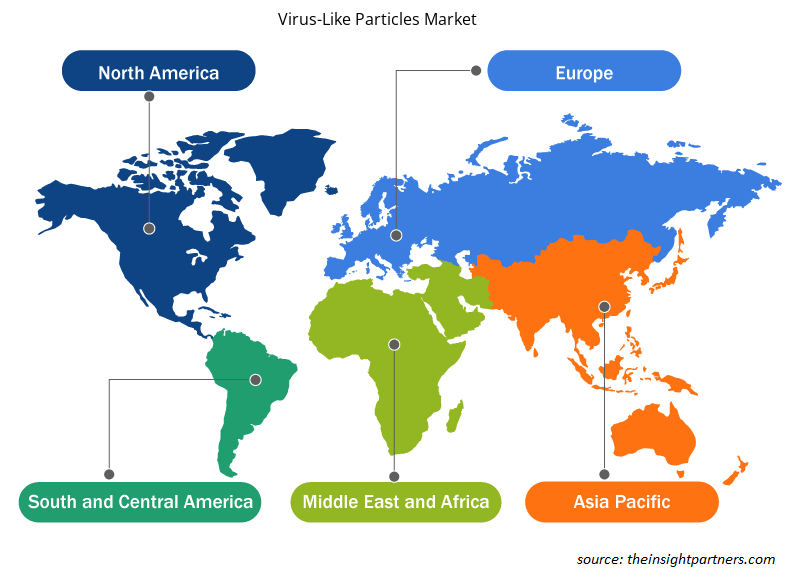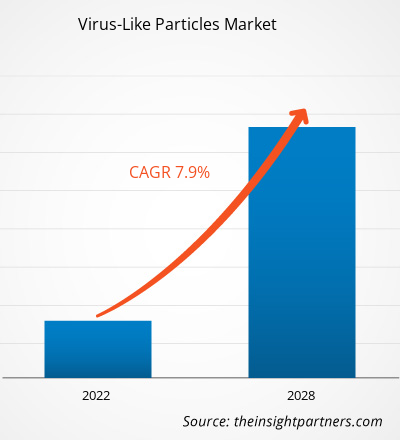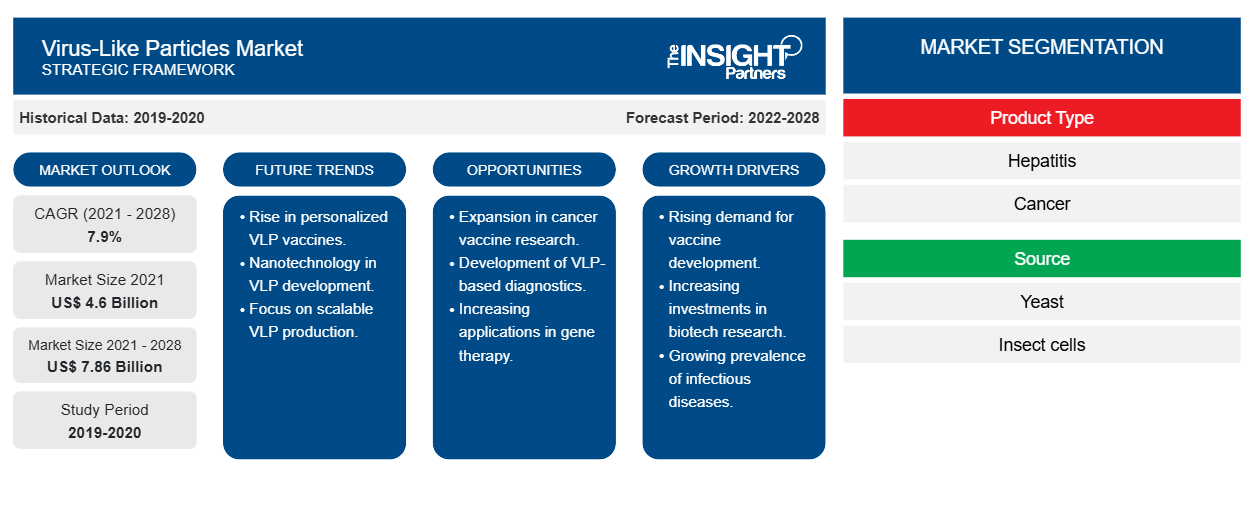Si prevede che il mercato delle particelle simili a virus (VLP) raggiungerà i 7.858,82 milioni di dollari entro il 2028, rispetto ai 4.601,84 milioni di dollari del 2021; si prevede una crescita a un CAGR del 7,9% dal 2021 al 2028. VLP’s) market is projected to reach US$ 7,858.82 million by 2028 from US$ 4,601.84 million in 2021; it is expected to grow at a CAGR of 7.9% from 2021 to 2028.
La commercializzazione di vaccini a base di particelle simili a virus contro virus umani e animali, le vigorose attività di ricerca e sviluppo per lo sviluppo di vaccini virali a base di particelle simili a virus e le particelle simili a virus che emergono come una piattaforma di immunoterapia affidabile per le malattie allergiche sono i principali fattori trainanti responsabili della crescita complessiva del mercato. Tuttavia, le sfide tecniche relative alla progettazione, alla purificazione e allo stoccaggio degli eVLP ostacolano la crescita complessiva del mercato. Inoltre, le complessità associate alla produzione di vaccini a base di particelle simili a virus, unite a costi eccessivi e requisiti di tempo dei processi (come l'elaborazione a valle per i vaccini a base di particelle simili a virus), limitano ulteriormente la crescita del mercato globale. Inoltre, le terapie a base di particelle simili a virus destinate a malattie virali topiche ed emergenti nonché al cancro sono ancora in fase di sviluppo, il che sta creando opportunità redditizie per la crescita complessiva del mercato.
È probabile che il Nord America continui a dominare il mercato delle particelle simili a virus nel periodo 2021-2028. Gli Stati Uniti detengono la quota maggiore del mercato nordamericano e si prevede che continueranno questa tendenza durante il periodo di previsione. Ciò è principalmente attribuito alla comune suscettibilità delle persone alle infezioni virali, come l'influenza virale causata da diverse varianti. Inoltre, le continue attività di R&S richieste per la produzione di vaccini vivi attenuati costringono le aziende biofarmaceutiche a optare per particelle simili a virus, il che supporta ulteriormente la crescita del mercato.
Personalizza questo report in base alle tue esigenze
Riceverai la personalizzazione gratuita di qualsiasi report, comprese parti di questo report, o analisi a livello nazionale, pacchetto dati Excel, oltre a usufruire di grandi offerte e sconti per start-up e università
-
Scopri le principali tendenze di mercato in questo rapporto.Questo campione GRATUITO includerà analisi di dati che spaziano dalle tendenze di mercato alle stime e alle previsioni.
Approfondimenti di mercato
I vaccini basati su particelle virali commercializzate guidano la crescita complessiva del mercato
Secondo un rapporto pubblicato da Frontiers Media SA, il primo vaccino a base di particelle simili a virus è stato progettato per combattere un virus mortale, l'epatite B , e i vaccini a base di particelle simili a virus hanno prodotto risultati di sicurezza promettenti rispetto ai vaccini tradizionali. Il primo vaccino a base di particelle simili a virus commercializzato era contro l'HBV. Inoltre, i vaccini commerciali anti-HBV, vale a dire "Engerix" prodotto da GlaxoSmithKline e "Recombivax HB" prodotto da Merck & Co. sono stati approvati nel 1980, ed erano tutti particelle simili a virus. Il successivo vaccino a base di particelle simili a virus disponibile in commercio è stato "Gardasil", che è stato approvato nel 2006 per prevenire le infezioni da papillomavirus umano (HPV). Inoltre, le particelle simili a virus sono utilizzate anche in medicina veterinaria. Il primo vaccino veterinario disponibile in commercio basato su particelle simili a virus si è dimostrato efficace contro il circovirus suino di tipo 2 (PCV2).
Il ruolo delle particelle simili a virus nello sviluppo di prodotti di immunoterapia contro le malattie allergiche stimola ulteriormente la crescita complessiva del mercato. Le particelle simili a virus sono utilizzate nel trattamento della rinite allergica, dell'asma e delle reazioni agli acari della polvere. I fattori sopra menzionati guidano la crescita del mercato complessivo delle particelle simili a virus in modo esponenziale. I vaccini con particelle simili a virus hanno mostrato una rapida risposta immunitaria con lievi reazioni cutanee come effetti collaterali.
Informazioni basate sul tipo di prodotto
In base al tipo di prodotto, il mercato delle particelle simili a virus è segmentato in epatite, cancro/HPV e malattia di Gaucher. Il segmento dell'epatite rappresenterebbe un'ampia quota di mercato nel periodo 2021-2028. Il rapporto di Frontiers SA evidenzia che il virus dell'epatite C (HCV) infetta il 2% della popolazione mondiale ed è una delle principali cause di malattie epatiche e trapianto di fegato. Questa minaccia medica può essere parzialmente affrontata con l'introduzione di nuove terapie antivirali . Ad esempio, un vaccino con un'efficacia del 50-80%, mirato agli utilizzatori di droghe per via endovenosa ad alto rischio, riduce drasticamente l'incidenza dell'HCV nella popolazione. Pertanto, le particelle simili a virus rappresentano una piattaforma di somministrazione del vaccino sicura e altamente immunogenica che induce una risposta immunitaria adattativa. Diversi vaccini basati su particelle simili a virus sono attualmente in fase di sperimentazione clinica; tuttavia, i vaccini VLP autorizzati per HBV e HPV sono in uso da molto tempo. Pertanto, i vaccini basati su particelle simili a virus hanno dimostrato la loro efficacia in relazione alle caratteristiche immunologiche favorevoli, rendendoli uno dei vaccini contro l'HCV più promettenti.
Approfondimenti basati sulla fonte
In base alla fonte, il mercato delle particelle simili a virus (VLP) è segmentato in lievito, cellule di insetti, piante e altri. Il segmento del lievito detiene una quota di mercato considerevole e si prevede che continuerà la tendenza simile durante il periodo di previsione. Le particelle simili a virus sono prodotte da sistemi di espressione eterologa, che coinvolgono lievito o baculovirus, nonché piante e batteri. La sicurezza dei vaccini basati su particelle simili a virus prodotti utilizzando sistemi di espressione di lievito contribuisce alla crescita del mercato delle particelle simili a virus basate su lievito.
Approfondimenti basati sulle applicazioni
Per applicazione, il mercato delle particelle simili a virus è segmentato in vaccini e terapie. Il segmento dei vaccini deterrebbe una quota considerevole del mercato nel 2021 ed è probabile che continui a dominare il mercato anche durante il periodo di previsione. La vaccinazione è considerata uno dei modi più efficaci per controllare i patogeni e prevenire le malattie, sia negli esseri umani che negli animali. I vaccini basati su particelle simili a virus rappresentano uno degli approcci più interessanti grazie alle loro proprietà immunogeniche intrinseche e alla sicurezza. Ad esempio, le particelle simili a virus sono antigeni multimerici non infettivi con una struttura particellare, adatti per l'induzione di una risposta immunitaria umorale e cellulare sicura ed efficiente. A parte questo, i vaccini con particelle simili a virus hanno dimostrato la loro efficacia nel campo veterinario. Le particelle simili a virus sono composte solo da una o più proteine strutturali senza presenza di genomi di virus nativi e non capacità di autoreplicazione nelle cellule. Tuttavia, particelle simili a virus contenenti antigeni monovalenti o multivalenti possono essere prodotte in conformità con il requisito di sorveglianza sierologica, l'utilità dei vaccini con particelle simili a virus si dimostra promettente nel campo veterinario. Un esempio di questo tipo di utilizzo di vaccini con particelle simili a virus nell'ambito delle strategie di vaccinazione Differenziazione degli animali infetti da quelli vaccinati (DIVA) contro le malattie animali.
Le aziende che operano nel mercato delle particelle virali (VLP) adottano una strategia di innovazione di prodotto per soddisfare le mutevoli esigenze dei clienti in tutto il mondo, il che consente loro anche di mantenere il proprio marchio sul mercato globale.
Ambito del rapporto di mercato sulle particelle simili a virus
Approfondimenti regionali sul mercato delle particelle simili a virus
Le tendenze regionali e i fattori che influenzano il mercato delle particelle simili a virus durante il periodo di previsione sono stati ampiamente spiegati dagli analisti di Insight Partners. Questa sezione discute anche i segmenti e la geografia del mercato delle particelle simili a virus in Nord America, Europa, Asia Pacifico, Medio Oriente e Africa e America meridionale e centrale.

- Ottieni i dati specifici regionali per il mercato delle particelle simili a virus
Ambito del rapporto di mercato sulle particelle simili a virus
| Attributo del report | Dettagli |
|---|---|
| Dimensioni del mercato nel 2021 | 4,6 miliardi di dollari USA |
| Dimensioni del mercato entro il 2028 | 7,86 miliardi di dollari USA |
| CAGR globale (2021 - 2028) | 7,9% |
| Dati storici | 2019-2020 |
| Periodo di previsione | 2022-2028 |
| Segmenti coperti |
Per tipo di prodotto
|
| Regioni e Paesi coperti |
America del Nord
|
| Leader di mercato e profili aziendali chiave |
|
Densità degli attori del mercato: comprendere il suo impatto sulle dinamiche aziendali
Il mercato delle particelle simili a virus sta crescendo rapidamente, spinto dalla crescente domanda degli utenti finali dovuta a fattori quali l'evoluzione delle preferenze dei consumatori, i progressi tecnologici e una maggiore consapevolezza dei benefici del prodotto. Con l'aumento della domanda, le aziende stanno ampliando le loro offerte, innovando per soddisfare le esigenze dei consumatori e capitalizzando sulle tendenze emergenti, il che alimenta ulteriormente la crescita del mercato.
La densità degli operatori di mercato si riferisce alla distribuzione di aziende o società che operano in un particolare mercato o settore. Indica quanti concorrenti (operatori di mercato) sono presenti in un dato spazio di mercato in relazione alle sue dimensioni o al valore di mercato totale.
Le principali aziende che operano nel mercato delle particelle simili ai virus sono:
- Merck & Co., Inc.
- Società anonima GlaxoSmithKline.
- Pfizer Inc.
- Tecnologie Dynavax
- Sanofi
Disclaimer : le aziende elencate sopra non sono classificate secondo un ordine particolare.

- Ottieni una panoramica dei principali attori del mercato delle particelle simili a virus
Mercato delle particelle simili a virus (VLP) – per tipo di prodotto
- Epatite
- Cancro/HPV
- Malattia di Gaucher
Mercato delle particelle simili ai virus (VLP) – per fonte
- Lievito
- Cellula di insetto
- Pianta
- Altri
Mercato delle particelle simili a virus (VLP) – per applicazione
- Vaccini
- Terapia
Mercato delle particelle simili a virus (VLP) – per area geografica
-
America del Nord
- NOI
- Canada
- Messico
-
Europa
- Francia
- Germania
- Italia
- Regno Unito
- Spagna
- Resto d'Europa
-
Asia Pacifico (APAC)
- Cina
- India
- Corea del Sud
- Giappone
- Australia
- Resto dell'APAC
-
Medio Oriente e Africa (MEA)
- Sudafrica
- Arabia Saudita
- Emirati Arabi Uniti
- Resto del MEA
-
America del Sud e Centro (SCAM)
- Brasile
- Argentina
- Resto della TRUFFA
Profili aziendali
- Merck & Co., Inc.
- Società anonima GlaxoSmithKline.
- Pfizer Inc.
- Tecnologie Dynavax
- Sanofi
- Società farmaceutica Wantai
- Istituto del siero dell'India Pvt. Ltd.
- BIOTECNOLOGIA DEL BHARAT
- LG Chimica
- Vaccini VBI Inc.
- Analisi storica (2 anni), anno base, previsione (7 anni) con CAGR
- Analisi PEST e SWOT
- Valore/volume delle dimensioni del mercato - Globale, Regionale, Nazionale
- Industria e panorama competitivo
- Set di dati Excel
Report recenti
Rapporti correlati
Testimonianze
Motivo dell'acquisto
- Processo decisionale informato
- Comprensione delle dinamiche di mercato
- Analisi competitiva
- Analisi dei clienti
- Previsioni di mercato
- Mitigazione del rischio
- Pianificazione strategica
- Giustificazione degli investimenti
- Identificazione dei mercati emergenti
- Miglioramento delle strategie di marketing
- Aumento dell'efficienza operativa
- Allineamento alle tendenze normative























 Ottieni un campione gratuito per - Mercato delle particelle simili a virus
Ottieni un campione gratuito per - Mercato delle particelle simili a virus